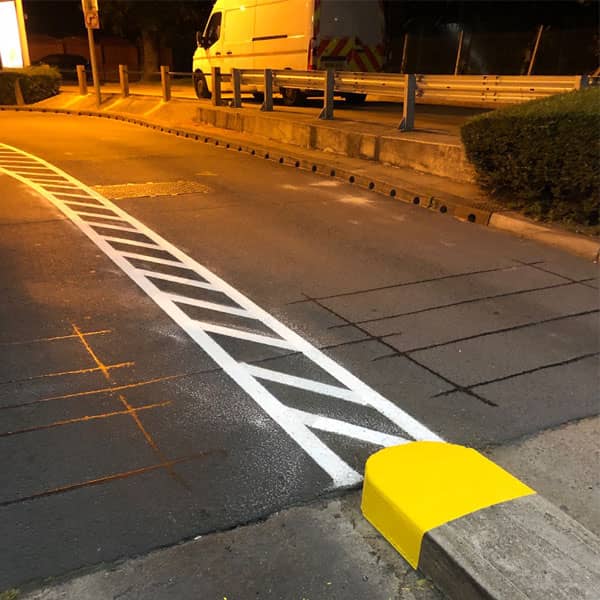The traffic levels (vehicular and foot)
The colours required
The road surface
If the lines require a reflective quality.
And… it’s not always (technically) paint
True, some road markings are installed using a type of cold-applied paint, but the type of road markings you see on motorways and dual carriageways etc., needs to withstand high levels of traffic, and remain functional for long periods, so are often created using a type of plastic.
So, what are the different types of road marking applications?
There are a surprising number of different types of road marking applications, each one suited to different surfaces and uses. But generally, in the UK, when installing road markings in a commercial capacity, there are three main types of line marking applications, including:
Thermoplastic
Perhaps the most commonly used road marking application, thermoplastic is a plastic polymer material, that when heated to specific temperatures becomes pliable, and when cooled, hardens to a consistency perfect for car park markings, playground markings and various types of line markings.
Key benefits of thermoplastic:
Thermoplastic is quick-drying:This benefit means road closure times are kept to a minimum as thermoplastic dries within just 10 minutes after application.
Thermoplastic is hardwearing: Depending on how it’s installed (including preparation) thermoplastic is extremely hardwearing and will remain functional over a long period, relevant to traffic levels.
Thermoplastic is available in a variety of colours: A benefit that comes in especially handy when creating vibrant and individual playground or warehouse line markings.
Thermoplastic has a reflective quality: This is due to the addition of tiny (harmless) glass beads, making thermoplastic one of the best applications for dimly lit roads.
Methyl Methacrylate (MMA)
Methyl Methacrylate abbreviated MMA, is another commonly used line marking application, used for marking roads, car parks, warehouses, playgrounds and more, and like thermoplastic, has a range of key benefits.
Key benefits of MMA
MMA has a long life expectancy: In certain circumstances, MMA can have a life expectancy of up to 20 years, depending on traffic levels, and the quality of the initial installation.
MMA is cold applied: This means MMA doesn’t require the same heat-producing equipment as thermoplastic, which can mean a faster application time.
MMA is quick-drying: MMA is quick-drying; although it takes a little longer than thermoplastic, it is still ideal for use where a quick return to service is required.
MMA is suitable for a variety of surfaces: Due to its chemical makeup and cold application, MMA is suitable for all types of road surfaces, including tarmac, asphalt and concrete.
Epoxy Resin
Epoxy resin is a type of line marking paint, and due to its consistency, offers road marking contractors and road users, a variety of benefits.
Key benefits of epoxy resin
Epoxy resin has anti-skid properties: This benefit makes epoxy resin ideal for warehouse line marking, where traffic is a combination of vehicular and foot.
Epoxy resin is chemical resistant: This is another reason epoxy resin is suitable for line markings in warehouses or factories, and other industrial units where there is a possibility of chemical spillage.
Epoxy resin is highly visible: Just like thermoplastic and MMA, once installed, epoxy resin is highly visible, even in areas where light is limited.
Epoxy resin is suitable for uneven surfaces: Due to its rubber-like consistency, epoxy resin can be applied to most surfaces, even if the surface is uneven.
Like to know more?
If you’d like more information on any of the products mentioned, or you’d like to hire City Road Markings for your line marking project, contact us, either via the website booking form, by email, or by phone, to speak directly to one of our line marking experts.
